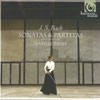Bach Solo Violin Sonatas & Partitas, BWV1004 - 1006
Isabelle Faust’s bold approach to Bach is captivating but Baráti fails to convince
View record and artist detailsRecord and Artist Details
Composer or Director: Johann Sebastian Bach
Genre:
Instrumental
Label: Harmonia Mundi
Magazine Review Date: 6/2010
Media Format: CD or Download
Media Runtime: 0
Mastering:
Stereo
DDD
Catalogue Number: HMC90 2059

Tracks:
| Composition | Artist Credit |
|---|---|
| (3) Sonatas and 3 Partitas, Movement: Partita No. 2 in D minor, BWV1004 |
Johann Sebastian Bach, Composer
Isabelle Faust, Violin Johann Sebastian Bach, Composer |
| (3) Sonatas and 3 Partitas, Movement: Sonata No. 3 in C, BWV1005 |
Johann Sebastian Bach, Composer
Isabelle Faust, Violin Johann Sebastian Bach, Composer |
| (3) Sonatas and 3 Partitas, Movement: Partita No. 3 in E, BWV1006 |
Johann Sebastian Bach, Composer
Isabelle Faust, Violin Johann Sebastian Bach, Composer |
Author: DuncanDruce
Baráti represents the traditional approach, though willing to acknowledge the desirability of historical correctness in such matters as adding cadential trills starting on the upper note. He’s an extremely able player, as readers who have heard his recent Paganini concertos disc will know, and much of the pleasure in listening to his Bach comes from admiring the precision of his fingerwork and from his confident surmounting of every obstacle.
A big disadvantage of this set for me is that in virtually every binary-form movement Baráti omits the second repeat. I suspect the reason for this is that he’s in the habit of performing all six works in a single evening, when he must be keen to cut the length of a very long concert. On a recording, however, it seems inexcusable, as the omissions spoil the balance of the individual pieces and of the sonata or partita as a whole. I’m not happy, either, about his technique for playing chords. In the sonatas’ fugues, he plays many chords without spreading, enabling a clear and precise rhythm, but often at the cost of unsuitably fierce attacks. Even when chords are spread there’s frequently a harsh initial accent (avoidable if the violinist saves the strongest tone for the end of any arpeggiation), giving an aggressive edge even to more lyrical pieces, for example the opening Adagios of the first two sonatas. Another problem, for me, is that Baráti is wedded to 20th-century tone production supported by vibrato. The eloquent life of Bach’s violin writing can, I feel, only be realised fully through the nuanced bow strokes that were the norm in the 18th century; and though Baráti is sensitive to the shape of Bach’s phrases and to the implications of the underlying harmony, the dynamic evenness of his playing tends to downplay the music’s expressive content.
Isabelle Faust, by contrast, aims at the most vivid presentation. Like Alina Ibragimova (Hyperion, 11/09) she uses little vibrato and employs the detailed marking of slurs in Bach’s autograph as a guide to phrasing and accentuation. But whereas Ibragimova’s performances are notable for their delicacy and intimate scale, Faust is bolder and more outgoing, introducing imaginative ornamentation into repeated sections. Quite often her playing allows a generous measure of rhythmic freedom – as in the Second Partita’s Sarabande, for example; at other times she’s concerned to maintain a strong momentum. The Chaconne is the most notable example of this: in her hands it sounds like the representation of a vast procession, moving forward inexorably. The Third Partita’s Prelude has a similar onward drive that’s in no way mechanical – constantly varied bow strokes express perfectly the changes in harmonic speed and fluctuation of intensity.
In short: Isabelle Faust has a magnificent grasp of this music. Hear her if you can!
Discover the world's largest classical music catalogue with Presto Music.

Gramophone Digital Club
- Digital Edition
- Digital Archive
- Reviews Database
- Full website access
From £8.75 / month
Subscribe
Gramophone Full Club
- Print Edition
- Digital Edition
- Digital Archive
- Reviews Database
- Full website access
From £11.00 / month
Subscribe
If you are a library, university or other organisation that would be interested in an institutional subscription to Gramophone please click here for further information.




